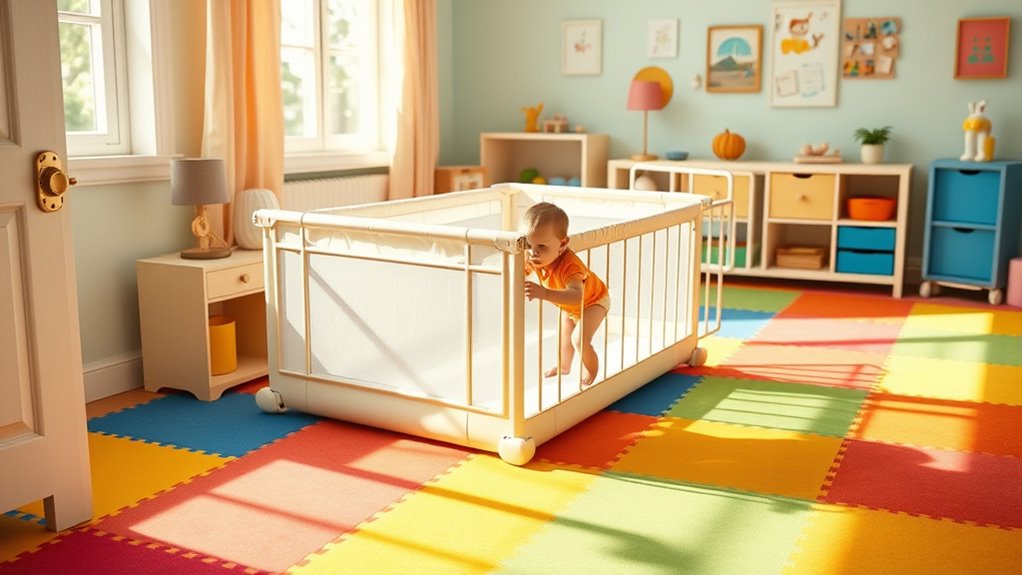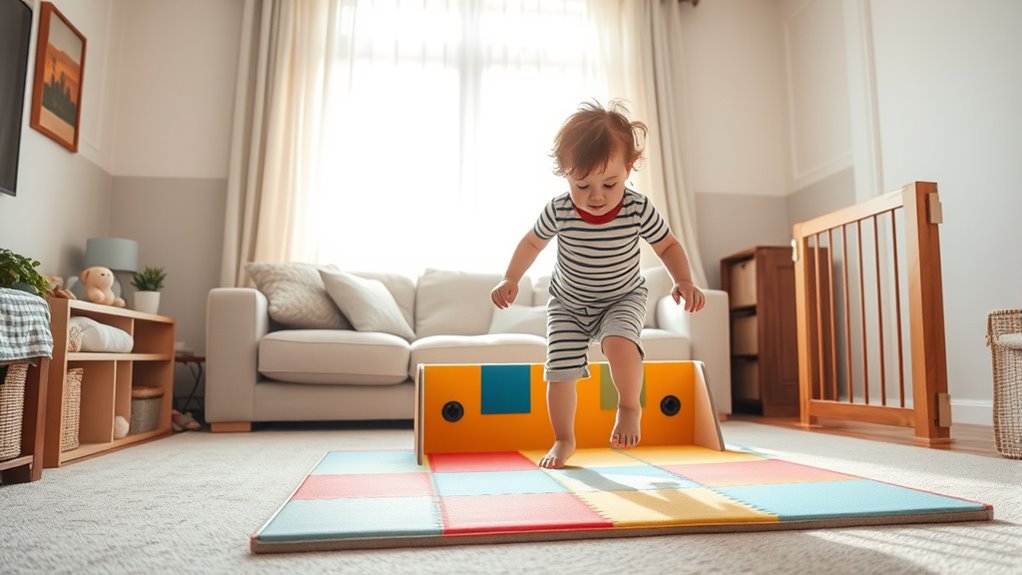To keep your climbing little one safe at home, install childproof locks on cabinets and drawers, and use safety gates near stairs and dangerous areas. Secure heavy furniture and cover electrical outlets to prevent injuries. Regularly check that safety devices work properly and remove clutter that could cause tripping. By taking these proactive steps, you create a safer environment for active explorers. Keep exploring ways to make your home even more secure for your curious toddler.
Key Takeaways
- Install childproof locks on cabinets and drawers to restrict access to hazardous substances and sharp objects.
- Use safety gates at stairs and doorways to prevent falls and keep climbing areas secure.
- Secure heavy furniture and cover electrical outlets to prevent tip-overs and electrical hazards.
- Remove or store small objects, toys, and clutter that could cause choking or tripping.
- Regularly inspect safety devices, adapt to your child’s growing abilities, and supervise their exploration.

When your little one starts exploring every corner of the house, toddler-proofing becomes crucial to keep them safe. At this stage, your child’s natural curiosity drives them to investigate everything within reach, which means hazards are just waiting to happen. To prevent accidents, start by installing childproof locks on cabinets and drawers. These locks are simple to use and keep dangerous items like cleaning supplies, sharp utensils, or medicines out of your child’s grasp. They’re an effective first line of defense that allows you to maintain access to necessary items while ensuring your little explorer can’t open potentially harmful containers.
Installing childproof locks on cabinets keeps dangerous items out of your child’s reach.
In addition, safety gates are essential in creating secure zones within your home. Placing gates at the top and bottom of stairs prevents falls that could cause serious injuries. They also help you block off rooms or areas that aren’t childproofed yet, like the garage or laundry room, where hazards such as chemicals, heavy objects, or electrical cords lurk. When choosing safety gates, look for sturdy models with secure latches that are difficult for little hands to open. Installing gates correctly and ensuring they are free of sharp edges reduces the risk of accidental falls or entrapment.
Beyond gates and locks, it’s important to evaluate each room from your child’s perspective. Think like a little investigator—what can they reach, climb, or pull down? Secure heavy furniture, such as bookshelves and dressers, to the wall to prevent tipping. Cover electrical outlets with safety covers, and keep cords out of reach to avoid strangulation or electrical shock. Remember, young children are quick and curious, so it’s imperative to stay vigilant even after installing safety devices. Regularly check that locks are functioning properly, gates are secure, and no new hazards have appeared as your child grows and explores differently.
Creating a safe environment also involves organizing and removing unnecessary clutter that can become tripping hazards. Ensure small objects, sharp tools, or breakable items are stored in high cabinets or locked away. Teaching your child about boundaries and safe play areas complements physical safety measures, helping them learn what’s off-limits while giving you peace of mind.
Toddler-proofing isn’t a one-time task; it’s an ongoing process that evolves with your child’s development. By using childproof locks, safety gates, and other safety measures thoughtfully, you create a safer space for your little explorer to grow, learn, and discover confidently. Staying proactive and attentive ensures your home remains a haven where curiosity leads to discovery without unnecessary risks. Incorporating survivalist techniques like having emergency kits and secure storage can further enhance your preparedness for unforeseen situations as your child’s independence increases.
Frequently Asked Questions
When Should I Start Toddler-Proofing My Home?
You should start toddler-proofing your home as early as possible, even before your little one begins to crawl. Early safety measures help prevent accidents and build a secure environment. Focus on baby proofing essentials like outlet covers, cabinet locks, and corner protectors. By proactively toddler-proofing, you create a safe space where your climbing explorer can explore freely, giving you peace of mind as they grow and discover their surroundings.
How Do I Child-Proof Stairs Effectively?
To really hit the nail on the head, you need to address stairway hazards head-on. Installing a sturdy safety gate at the top and bottom of your stairs acts as a first line of defense. Make sure the gate is securely mounted and out of reach of your little climber. Regularly check for loose hardware or wear, and keep stairs clear of toys to prevent accidents.
What Are the Best Safety Gates for Toddlers?
When choosing the best safety gates for toddlers, you want reliable baby proofing essentials that prioritize safety and ease of use. Look for gates with secure locking mechanisms, adjustable widths, and durable materials. Consider toddler safety products that fit your space and are easy to install. Metal or pressure-mounted gates work well for most homes, ensuring your little climber stays safe without compromising accessibility. Always select certified, high-quality options for peace of mind.
How Can I Prevent My Child From Choking?
Preventing your child’s perilous predicament starts with proactive prevention. You can protect against choking hazards by carefully selecting safe snacks, avoiding small objects, and supervising mealtime. Keep small items out of reach, and teach your child to chew thoroughly. Regularly inspect toys for damage, and always stay vigilant during play and meals. Prioritizing child safety helps prevent potential choking incidents, giving you peace of mind and your little explorer a safer space to discover.
Are There Safe Ways to Child-Proof Electrical Outlets?
To keep your child safe from electrical hazards, you should use electrical outlet covers to prevent accidental poking or inserting objects. guarantee socket safety by choosing covers that are snug and tamper-resistant, making it difficult for your little explorer to access the outlets. Regularly check that the covers are secure and in good condition. These simple steps help protect your child from potential electrical shocks and keep your home safer.
Conclusion
By toddler-proofing your home, you’re not just creating a safe space—you’re building a fortress against chaos! With everything secured and hazards banished, you’ll sleep easier knowing your little explorer can climb, crawl, and conquer without turning your house into a disaster zone. Think of yourself as the superhero of safety, armed with baby-proof locks and corner protectors, ready to thwart any toddler-tornado. Now, go forth and transform your home into the ultimate toddler-titanium fortress!










